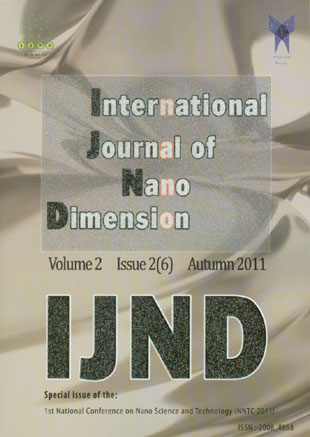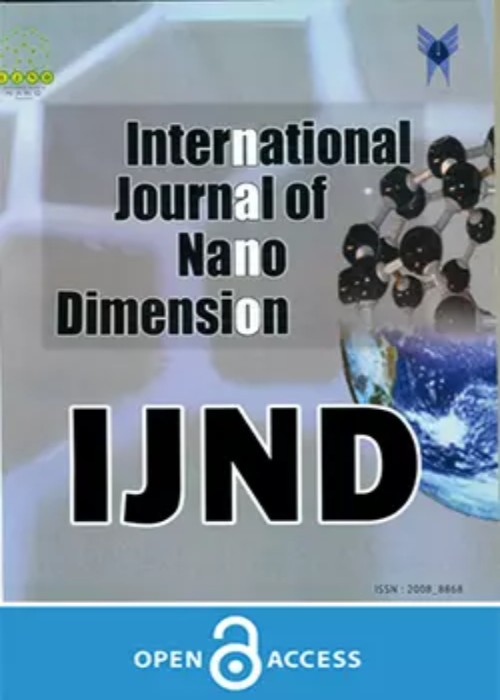فهرست مطالب

International Journal of Nano Dimension
Volume:2 Issue: 2, Autumn2011
- 80 صفحه،
- تاریخ انتشار: 1390/08/01
- تعداد عناوین: 8
-
Pages 85-103Nowadays various methods are presented for synthesis of barium strontium titanate (BST) nanopowders with different morphology and properties. Each of these (BST)s has got individual characterization that makes it suitable for a special application. Every method has a special quality, causes it to have preference over the other methods. Low processing temperature is a desired point which most of methods are aimed to reach. Below are some BST properties and fabrication routes summarized.X-ray diffractometer is used to investigate the characterization of synthesized BST and in some methods analysis of electron microscopy and Energy Dispersive X-Ray Spectroscopy are provided.
-
Pages 105-110The magnetite (Fe3O4) – agar nanocomposite was prepared by co-precipitation of Fe (III) and Fe (II) ions for the first time. The obtained samples were characterized by x-ray diffraction, Fourier-transform infrared spectroscopy, scanning electron microscopy and transmission electron microscopy. FT-IR results confirm the formation of Fe3O4 nanoparticles in agar matrix. The XRD results revealed the presence of magnetite nanoparticles. The SEM results confirm that the magnetite nanoparticles are dispersed in the agar matrix. TEM micrograph clearly illustrates that the magnetite nanoparticles sizes varies from 50 – 200 nm.
-
Pages 111-116Magnesium hydroxide Mg(OH)2 nanorods with diameters of 90±10nm and lengths of more than 2μms were prepared by a simple route at ~75oC in ambient air. The approach is based on reaction of magnesium powder and de-ionized water without the use of any harmful, toxic or corrosive reagents. Characterization using X-ray diffraction (XRD) shows single crystalline structure of Mg(OH)2 (brucite) whereas Scanning Electron Microscopy (SEM) showed that nanorods are almost uniform in size. Since only water is used as a solvent as well as a source of oxygen, we believe that this manufacturing process is suitable for mass production of nanostructures safely.
-
Pages 117-123ZnO and ZnO:Mn nanocrystals synthesized via reverse micelle method. The size, band gap, Urbach energy, optical constants and penetration depth of nanocrystals were calculated by UV-vis spectroscopy data. The surface morphology was studied with the use of scanning electron microscope (SEM). Moreover the samples exposed to Gama ray source of 60Co and their thermoluminescence properties were also investigated.
-
Pages 125-127In this scientific research ZnS nanoparticle was synthesized via precipitation method. Two samples were synthesized by this method. The nanoparticle was characterized by XRD techniques, and the size and kind of crystallinity were identified by X-ray diffraction pattern as well. The size measurement has been done by using scherrer's equation. The average sizes of nanoparticles in two samples were 11nm and 23nm. In fact, the velocity of stirrer affects the size of particles. Moreover, the study of XRD pattern indicates the cubic structure. This nanoparticle exposed to Gama ray source of 60Co and investigated their thermoluminescence's properties. The result shows that the thermoluminescence intensity increases by the size reduction of nanoparticles
-
Pages 129-135Recombinant protein purification is a kind of sensitive and expensive method in genetics engineering. Genetic manipulation leads to the expression of various proteins; it should be isolated with high purity finally. Differed methods for protein purification are categorized, based on cast, quality, Easy work and side effect of protein. In this article, we are investigating his His-tag protein purification by magnetic nanoparticles.NiFe2O4 nanoparticles were synthesized by Co-precipitation method, than was dissolved in 0.05 NaCl solutions. Tube containing of nanoparticles and buffer was located in magnetic field. Nanoparticles were separation by the three-stage washed. According to the protocols, nanoparticles located in his-tag protein and the end protein were predicated, and analyzed by the Electrophoreses.The results of gel showed can be extracted that the proteins form a weak that the results of gel showed that proteins isolated are poor by this method. By supplementary study, we get new age or tree-age nanoparticles, that Ni is the surface of N.P. This age of nanoparticles is fit to protein purification.Nano-particle synthesis in this article, are created a two-dimensional grid of nickel and iron oxide nanoparticles that this structure is not suitable for purification of His-tag protein. So the magnetic nanoparticles have a three-dimensional structure of the nickel nanoparticles on the surface of the exposed histidine to be enough space to connect and link. It is hoped in future studies with these types of nanoparticles synthesis to achieved His-protein isolation kit
-
Pages 137-145In the present study, comparison of photocatalytic activity of nanostructures semiconductor zinc oxide (ZnO) was prepared using the different methods on the degradation of organic dye such as methylene blue that was investigated. Previous studies have proved that such semiconductors can degrade most kinds of persistent organic pollutants, such as detergents, dyes, pesticides and volatile organic compounds, under UV-irradiation. in some observed reports the photocatalytic activity of the coupled photocatalysts, evaluated by using organic dyes photodegradation as a probe reaction which shows increase the photocatalytic activity in different coupled photocatalysts. In this survey, the activities of ZnO nanostructures and ZnO nanocrystalline, for degradation of methylene Blue are different. Also the rate of operation photocatalysts ZnO nano composites on the organic dye is different too. Measurements of catalyst characteristics were obtained by BET, XRD, TEM, AFM, Raman and FTR-IR spectroscopy.
-
Pages 147-149Molecular sieves and zeolites are materials whose crystalline frameworks form nanometer or subnanometer pores. A variety of different crystal structures are known having a range of pore sizes. Because the pore sizes are usually smaller than 2 nm, they are classified as microporous materials. Synthesis of microporous materials is usually conducted by the high temperature treatment (80-200 °C) of aqueous synthesis gels. The process of heating aqueous mixtures to elevated temperatures for crystallization is typically described as hydrothermal synthesis. A hydrothermal treatment has been used to synthesize nano-sized AlPO4-5 (AFI) crystals. The treatment involved three main steps: (1) to prepare a synthesis gel and let it get well mixed, then filling autoclave with the gel and sealing it; (2) crystallization at 180 ◦C for 6 h; and (3) Calcination at 600 ◦C for 4 h to separate template materials. The crystals have been structurally characterized using X-ray diffraction (XRD), scanning electron microscope (SEM), energy dispersive X-ray analysis (EDAX). The analyses show an acceptable fitness to the referred pattern. The SEM analysis and Scherer equation revealed that the size of the obtained AlPO4-5 crystals was about 65 nm.


